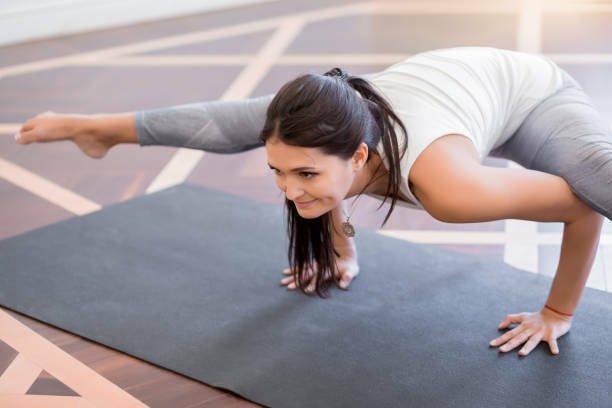“Lengthen your spine!”
A common cue in any yoga class, it almost reminds you of your mum yelling at you to stop slouching when you were a kid.
When we think of asanas involving the spine, top of mind are forward folds like uttanasana, back bends (spinal extensions), twists (axial rotations), side bends (lateral flexions) or simply standing tall in tadasana. One area of application I’ve found where the conscious lengthening of the spine gives an added edge is in the practice of arm balances.
What has the spine got to do with balancing on your arms?

Directly supporting the spine are the three sets of muscles that make up the erector spinae: running along the entire vertebral spinous process (spinalis), from one vertebral transverse to another (longissimus) and from one rib cage to the next (iliocostalis). Synergists here are the back muscles comprising the deep muscles of the quadratus lumborum (QL, and also the psoas major) that wrap around and stabilise the lumbar region, and the more superficial latissimus dorsi or lats that are activated in twisting postures and arm extensions.
While the lengthening of the spine is not the primary technique to get you lifting in an arm balance (engagement of the upper back, arms and abdominal core muscles are crucial for this), what it does is build up the supporting muscle memory that over time, will allow you to find more focus, steadiness and alignment in these asanas.
Before I go further, I would like to clarify that this blog is about technique refinement rather than a technical guide on getting started in arm balances.
2.46 sthira sukham asanam
Asana should be steady, stable, and motionless
Two arm balances where I’ve found more hang time by consciously recruiting the entire spine and lower back musculature (QL and lats) are eka pada bakasana and koundinyasana (symmetrical variation).
Eka pada bakasana, a level up version of bakasana, requires that bit more awareness of the role of your spine in the balance.
Most practitioners enter the pose in one of two ways – either from adho mukha svanasana or from bakasana and shifting the weight onto one side. Either way, remember to always lift your hips high. Hips are heavy and are the centre of gravity of the body, so lifting them high creates lightness and more lift for your lower limbs.
Next, get your drishti on point. You should ideally be gazing between your nose, at a point on the ground just a few inches in front of you. Yes – the ground is just a few inches in front of you so face planting is a looming threat. But fret not, it’s here where the lengthening of the spine (along with the critical supporting structures of the arms, upper back and core) comes into play.
Observe here how your drishti “anchors” the neck or cervical as it reaches forward, while lifting the hips up “pulls” the sacrum and coccyx away in the other direction. This is the effect of lengthening the spine.
Assuming here that you are starting to lift and extend one leg – point the toes of your extended leg for an added engagement of the hamstring muscle, you will find even more of that spinal extension. Your upper body is now suspended in a diagonal equilibrium, with the lumbar and sacrum extending up and out (by the lift of your hips and plantar flexion of foot engaging the hamstrings of the extended leg) and your drishti “grounding” you as you press firmly down with chaturanga arms.
In koundinayasana (with both arms), unlike its more popular eka pada version or eka pada bakasana above, the spine is parallel to the ground. This time, keep extending the sit bones back while lengthening across the entire spine especially in the lumbar region. Instead of gazing down, drishti remains between your nose but gazing straight ahead in the space before you.
Asanas that work on spinal extension
I personally find these asana variations extremely helpful for teaching the spine how to lengthen while holding space:
- Trikoasana with both arms extended over the head (think about holding a beach ball)
- Virabhadrasana 3
- Ardha prasirita padottanasana (once again, arms extended over the head)
They are particularly useful to awaken the lats too.
Notice that these three asanas are open-chain movements for the upper body, which teach balance and awareness while also isolating specific muscles, in this case the erector spinae, QL and lats (among others). Closed-chain movements like santolasana (plank), vasisthasana (side plank) or chaturanga dandasana are also extremely effective in working the entire backline, shoulder girdle and abdominal core, although they do not impart the same muscle memory required for lengthening the spine in an open-chain movement such as arm balances.
Teacher – and mum – are right: always lengthen your spine!
References:
Ray Long: The key muscles of Hatha Yoga.





